Just in time for the Thai New Year festival, Songkran, we will finally make a pot of Kaeng Khiao Wan after fooling around with other stuff. Your curry paste is ready…homemade or not…it’ll be fine either way.
Once you have that most important ingredient, then the rest is easy. You just go search your fridge and find one choice of protein and one choice of vegetable. And no, I’m not limiting you to just one of each, but you need to have at least one. I put two kinds of meat and three kinds of vegetables in my curry, and no one has given me a citation yet.
This is YOUR choice and your preference. I would recommend ingredients readily at hand or whatever is in season at the time. I’ve made a fish curry with squash blossoms, venison with tomatoes, tofu with mushrooms, shrimp with asparagus and tomatoes, pork with kubocha pumpkin, chicken with guava. Anything you can imagine; be bold and experiment.
Traditionally, you will see chicken curry with Thai eggplant, beef curry with pea eggplant, fish ball curry with fingerroot and Thai eggplant the most. Eggplants appear most often because they are readily available in Thailand and so tasty when they’ve soaked up the curry. Eat your curry over fluffy white jasmine rice. Ummm, just writing about it makes me hungry. I’m going to make a sample pot with beef shank and Thai eggplant. I also happened to have kabocha squash left over in the fridge from making pasta (that I ate with green curry with shrimp and tomatoes) the other day. So, I’m going to put them in the curry too.
I use the beef shank in the curry because it tolerates the cooking and simmering very well. It makes the the normally tougher cut tender. Just simmer them and they will come out melting in your mouth.
Let’s gather ingredients! Keep in mind that the amounts of each ingredient are only guidelines and can be adjusted base on your preference.
Ingredients
Green curry paste 3-6 tablespoons, depending on how spicy you want; I used about 4 tablespoons
Beef shank or other kind of protein–chicken, shrimp, fish, tofu, etc. trimmed and cut about 1 1/2 inch thick, 1 lb.
Coconut cream 2 cups I use the brand Aroy-D
Thai Eggplant or other kind of vegetables, eggplants, carrots, squash, pumpkin, etc., cut in to small pieces 2 cups (I used one cup of Thai eggplant and one cup of leftover kabocha squash.)
Thai basil, pick only the leaves, discard the stems 1/2 cup
Fish sauce 2 tablespoons
Coconut palm sugar 1 tablespoon
Water
Salt as needed
Note: Green curry paste is the one we made from the recipe I gave you last time. If you use a pre-made curry paste I don’t know the strength of the paste so be cautious, if you don’t want your curry to be too hot. You can stir-fry the entire amount you expected to use, but add it to the pot of curry a little at a time, starting at 2 tablespoons, and you taste it as you add to adjust to the right amount.
Coconut cream is preferably fresh squeezed but if you don’t want to make that effort, skip the next four paragraphs and go buy coconut milk or coconut cream in the can or box. It’s okay too. I just want to add this so people who want to take the time and do it just like in Thailand would know how.
If you can get your hands on coconut–either dried and shredded, frozen shredded, frozen cut in pieces or whole coconut–then you can squeeze your own coconut milk. The proper fresh coconut for coconut milk is at least half an inch thick inside the shell. If you already have one in pieces, check to see how hard it is It should be hard and firm, not thin and flimsy. The firmness should be about the same as Granny Smith apple. You should be able to slice the pieces thinly and they still hold stiff, not letting gravity get the best of them.
Why am I so fussy? Because if you get coconut that’s too young, you won’t get thick enough coconut milk. If you have frozen shredded coconut or dried shredded coconut, you really can’t tell much about it. I can tell because I have seen them all at every stage. I can tell you that most shredded coconut is good enough.
OK, once we eliminate the under-age candidate, then we’re ready to squeeze. The coconut flesh needs to be shredded or grated. We are going to use the blender method. You at least own a food processor or blender, right? That will be our tool. In Thailand we would just go buy fresh grated coconut from the market (We call it Ma Praw Khood), add warm water and squeeze. Here I just put pieces of coconut in the food processor and let the machine shred them for me. You can add a little liquid but if your machine can operate without it, you don’t have to.
Once you get the shredded coconut, add very warm water to it. You can boil water and mix the boiling water with room temperature water with 1:1 portion. Add water just to the level of covering the shredded coconut and let it sit for at least five minutes. Then get a mesh colander or cheesecloth. Strain the contents through the mesh and start squeezing the wet shredded coconut (of course you save ALL the liquid). Repeat the process again at least 2 times with the same shredded coconut but keep the coconut milk all separate in separate bowls. These are call Ka Ti Sod in Thai. Ka Ti = Coconut milk.
For dried shredded coconut, as long as it is not sweetened or baked, you can use it. Soak it in warm water until it comes back to life again, then put it in a blender with water, give it a swirl. You don’t need to puree it, though. Then follow the instructions above.
Let the coconut milk you just made sit in peace without any disturbance for at least 10 minutes in a warm place, or until it separates into two layers that you can obviously see. The top part is the coconut cream or Hua Ka Ti (Coconut milk “head”). You should skim all of it if possible, save it in a bowl together. You can see that from three bowls, you can get the most coconut cream from the first bowl and the rest are less and less content of the cream. Keep the rest of the content that I would call it “skimmed coconut milk” in English but the Thai would call it Hang Ka Ti (Coconut milk “tail”). You can combine the “skimmed coconut milk” together in a container but separate from the coconut cream. The coconut cream might need to be mixed with these coconut skimmed milk later.
This is the part that you have to read through at least once before you start, and you might want to refer back to it during the cooking.
In the picture I cooked the curry paste using a wok and then transferred the curry into a pot. You don’t need to do the same. You can start cooking in the pot so you don’t need to clean both the wok and the pot. I just like to make my husband wash a lot of pans. ;-p
1) Cook 1/2 of your coconut cream over medium-high heat until it starts to break. You will see a layer of film start to form.
Think of coconut milk like milk and coconut cream like heavy cream. It acts the same way. With store-bought coconut milk, place it in warm place for a while, and the cream should float to the top and you can skim it. When you buy a can of coconut milk, you might see it already separated if you don’t shake the can before opening. BUT Some coconut milk contains additives or emulsifier that keep the coconut milk from separating. That foreign additive could be flour, starch, Guar Gum or something else that I don’t know. In that case, the coconut milk will not separate under any circumstance. That’s the reason why I specify the brand of the coconut milk I used. I’m not trying to collect the advertising revenue but it’s the brand I’ve found that could split when I cook!
For people using the coconut milk that will never separate even though you threaten that it’s the end of the world, then you should add the coconut oil while you stir fry the curry paste. I normally don’t use the cold press, expensive, virgin or extra virgin coconut oil, but just regular coconut oil but if you can’t find it, virgin coconut oil is better than vegetable oil, but you have to pay the virgin surcharge. Mix about 2 tablespoons of coconut oil (depend of how much oil you want on top of your curry) with 1/2 cup of coconut cream, heating it until the mixture is bubbling.
Most of my Thai cooking guru friends (who really are legend of the Thai cooks) asked me to warn you that DO NOT USE THE VEGETABLE OIL, OLIVE OIL OR ANY OTHER FOREIGN OIL to cook the curry as most recipes on the internet would tell you. I totally agree.
When you heat the coconut cream (cream not milk remember that), the contents will start to break. You can see the fat separate from the cream.
Why do I have to do that?
Because the curry paste needs to be cooked at a higher temperature in order to release the aromas. If you cook it in just coconut milk, you’re just boiling it and never get the full flavor out of the curry. We need to stir fry or “Pad” the curry paste.
2) Add the curry paste to the bubbling coconut cream that already has some coconut oil mix in (either from the heat until the cream breaks or from mixing it in directly since you can’t get the coconut milk to break) and lower the heat to medium.
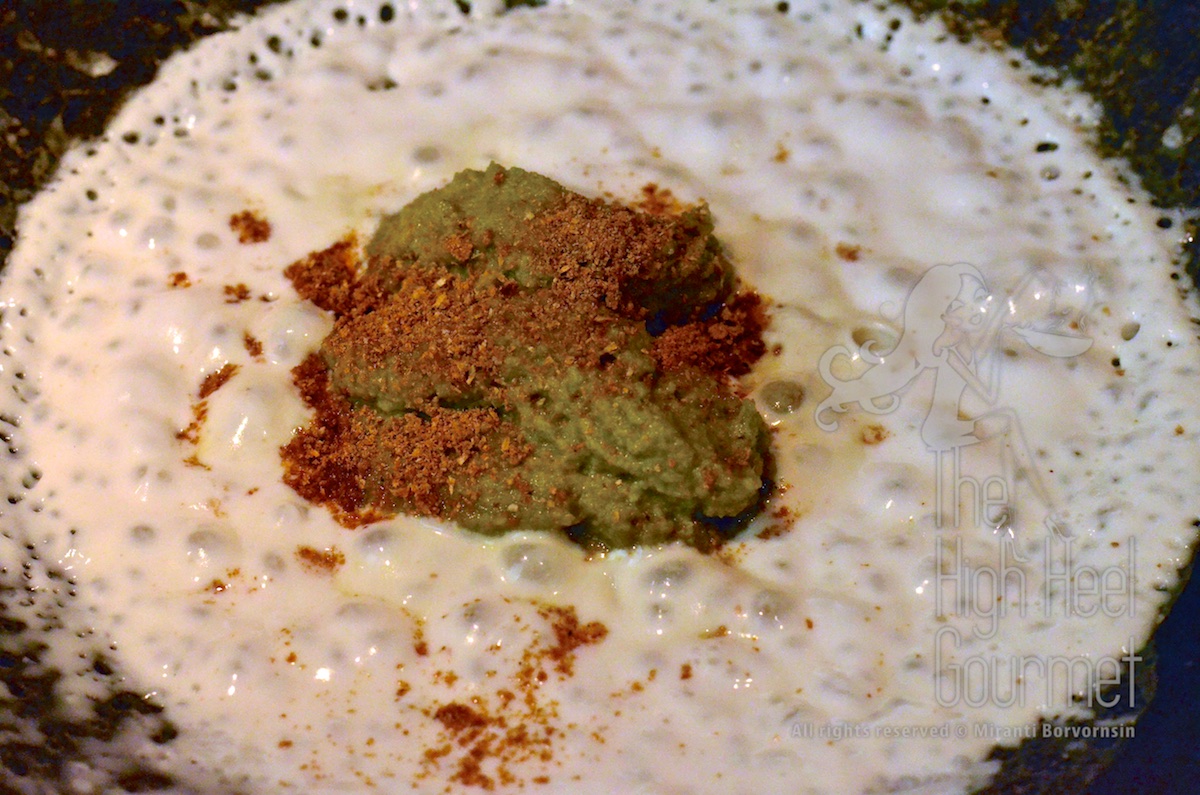
Adding the curry paste. I cook beef curry so I add more spice to the curry paste, 1 teaspoon of coriander seed, 1/2 teaspoon of cumin and a pinch of nutmeg.
Stir-fry the curry paste and keep it bubbling.
Keep adding more coconut milk or coconut cream to the EDGE of the pot or wok to prevent the paste from drying and burning.
This process will give your house the pungent smell of the Far East. You might sneeze a few times. That’s normal. However, if your co-worker sneezes the NEXT DAY when you toss your hair or just simply walk by, then that’s a problem. You might need to install a new vent in your kitchen! You should cook the curry paste for at least two to three minutes. I usually go slightly longer (never use the stop watch to see how long it is exactly…sorry…I will next time).
The curry paste needs to be cooked throughly or it will make your pot of curry bitter. I cook it until I see the coconut milk break even more. (See both bottom pictures, left and right above)
In this step I let the coconut cream break into oil even more just to get color.
A good Thai curry will have some colorful oil floating on top. How much of the oil depends on you. I like very little oil so I won’t let it break so much. A friend of mine likes a lot of oil on top (like a quarter inch thick), so he has to let it cook much longer. Also when you eventually add more coconut milk to the entire curry, the coconut milk (or actually the cream) will break even more. So, be prepare to get more oil. If you want to cook it longer, keep adding the coconut cream to the content to prevent it from burning.
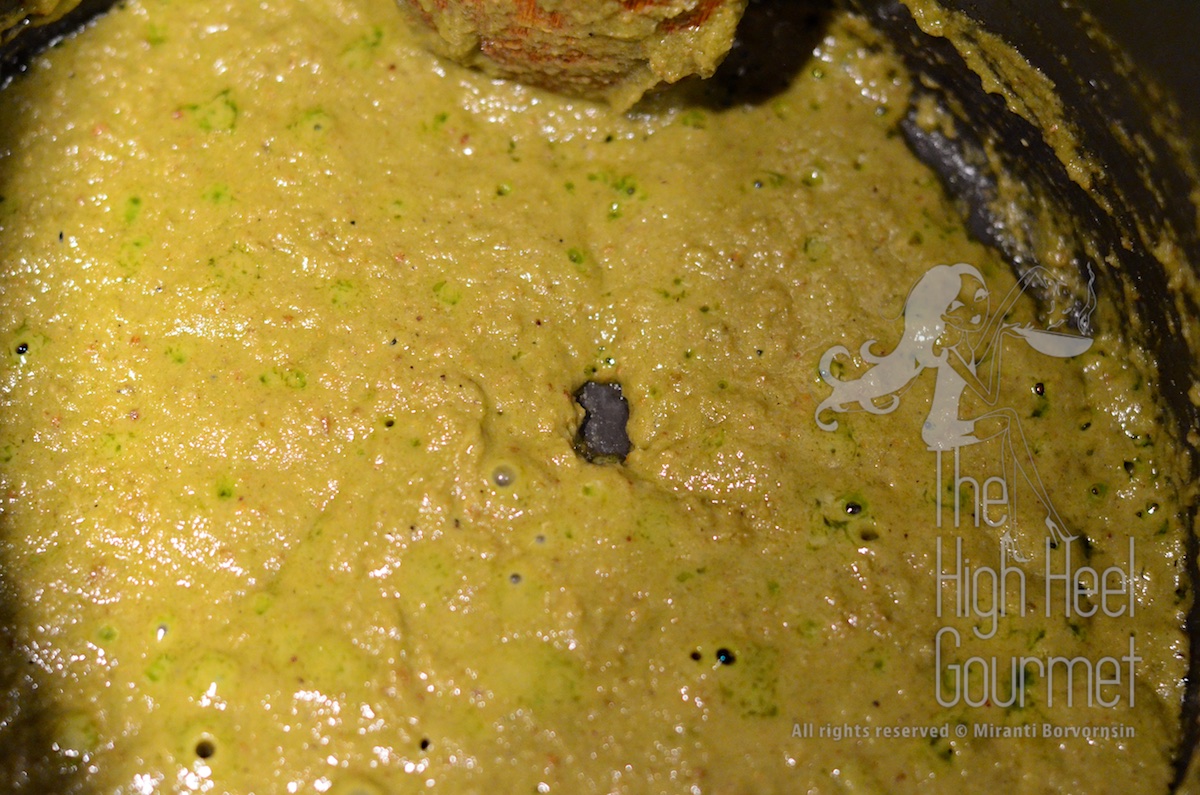
This is what I mean by let the coconut cream split. The green dots are the oil that was separated from the coconut cream. You can see the color of the oil. That will be floating on top of the curry to add the beautiful green color to the curry.
This oil on top of the curry shows how well you know how to cook the curry. If your curry looks “dull”, meaning no oil on top, you don’t know how to make the curry the right way and this is what this second step is all about.
NOTE: If you are not sure how much curry past you want to use, cook a lot of curry paste and set some of it aside for now.
3) Once you cook the curry paste, then you are ready for the meat. Add the meat of your choice to the cooked curry paste and coconut cream.
This step is just like searing the meat before you stew it, but use less heat to prevent the curry paste from burning…no biggie!
Once you are done searing the meat, if you cooked the curry paste in a wok like me, you should now transfer it to a pot. I chose the beef shank, which needs a long time to cook. I transfer the meat and cooked curry paste to the pot and add the water or the skimmed-coconut milk to cover the meat.
Bring it to boil and simmer for at least 2 hours until the meat is tender.
If you use chicken or seafood you don’t need to do this. I used water or skimmed coconut milk because I have to cook the meat for a long time and I don’t want the coconut cream to break, because at the end I would get a pot of thin curry with thick green oil on top.
NOTE: If you chose to use shrimp or other seafoods, save the shrimp to the end so it won’t overcook.
4) Once the meat is tender,
you can add more coconut cream and vegetables. Cooking a pot of curry is the same as stir-frying; you have to know the cooking time of each ingredient needs and arrange them in order to make sure that EVERYTHING finishes cooking together perfectly at the end. You don’t put eggplant in the pot before meat that needs to be cooked for a long time, for example.
I put kabocha squash in first and waited until it was nearly cooked.
Then added the eggplants.
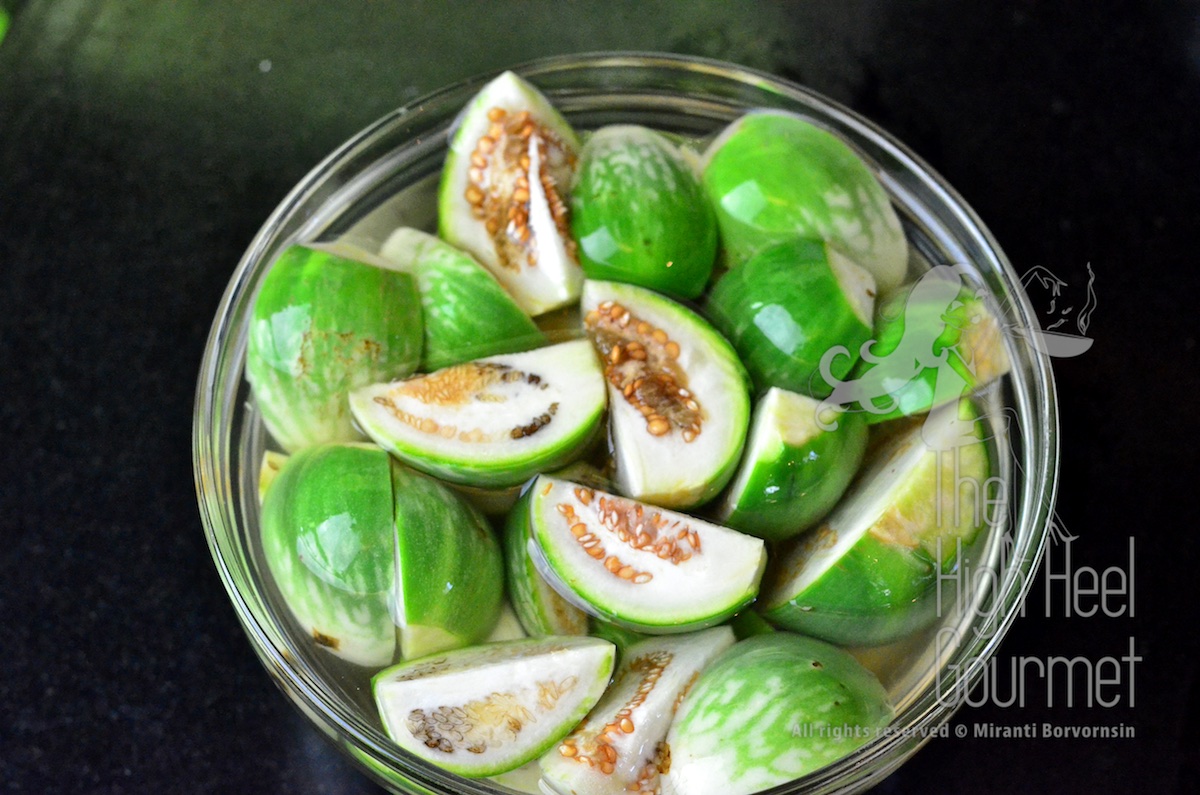
Cut up Thai eggplants. I soak them in salted water to prevent them from turning brown when they touch the heat.
If you haven’t already seasoned the curry, now you can do so. The curry should be salty with a hint of sweetness, but not too sweet. I don’t put more than two tablespoons of fish sauce and season it with salt instead of fish sauce. If you don’t mind the flavor of the fish sauce, you can add more. Everything is up to your preference, including the thickness of the curry.
I like my curry very thin but flavorful. My husband likes it very creamy. So, I reserve some coconut cream on the side and add it to his bowl when I serve it. There is no right or wrong with a bowl of curry. Everything is up to your personal taste. In Thailand you will find most of the curries are thinner and way spicier than the curries served at Thai restaurants here.
My friend went to live in Thailand for nearly two years, came back and told me he never have a bowl of good curry there because he likes his curry thick, no-oil-on-top and very mild curry (almost like a white, thick soup in the bowl) of which Thai people would not even consider that a “curry” yet. It’s all personal.
Now both vegetables should be perfectly cooked by the time I’m done seasoning the curry and have turned off the heat.
5) Add the Thai basil leave AFTER you turn off the heat.
That basil is very sensitive to heat, so just the left over heat from the curry is enough to wilt the basil.
I allow you to eat the curry you had just made now…enjoy!
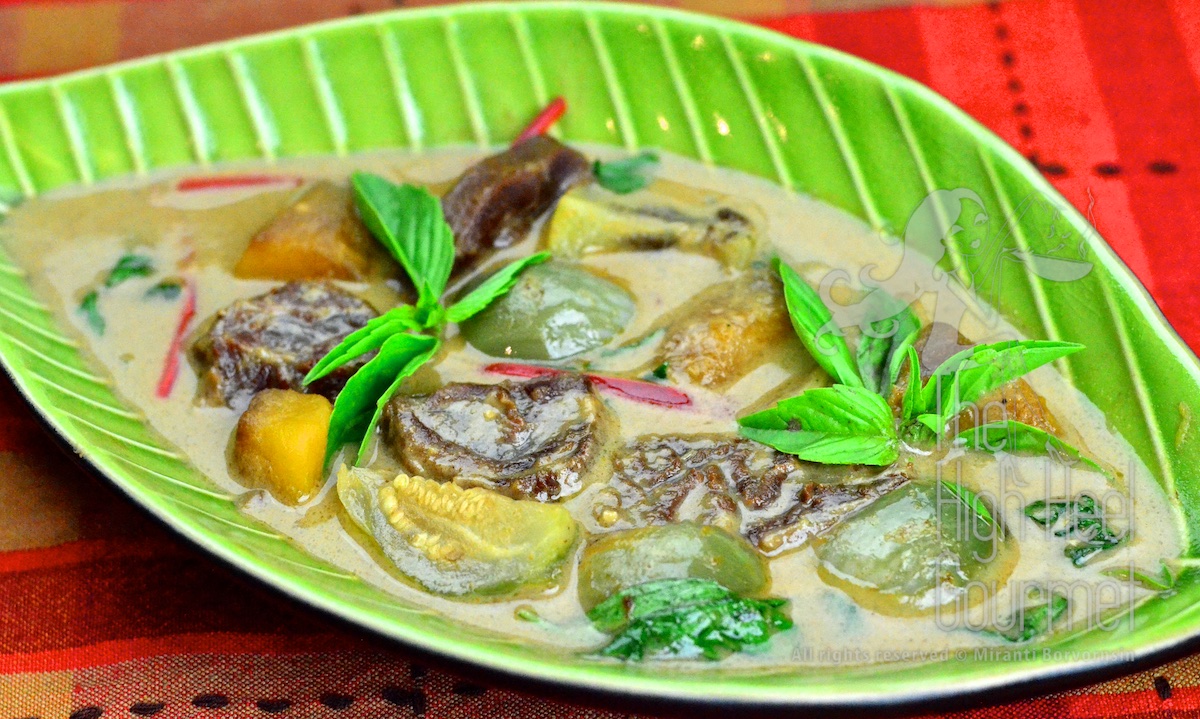
My curry had lost the “gloss” or the green coconut oil during the process of cooking the kabocha squash. The squash broke down and became “starch” that emulsified the oil that was carefully separated from the coconut cream back to the soup. This can happen when you add a high starch vegetable to the curry.

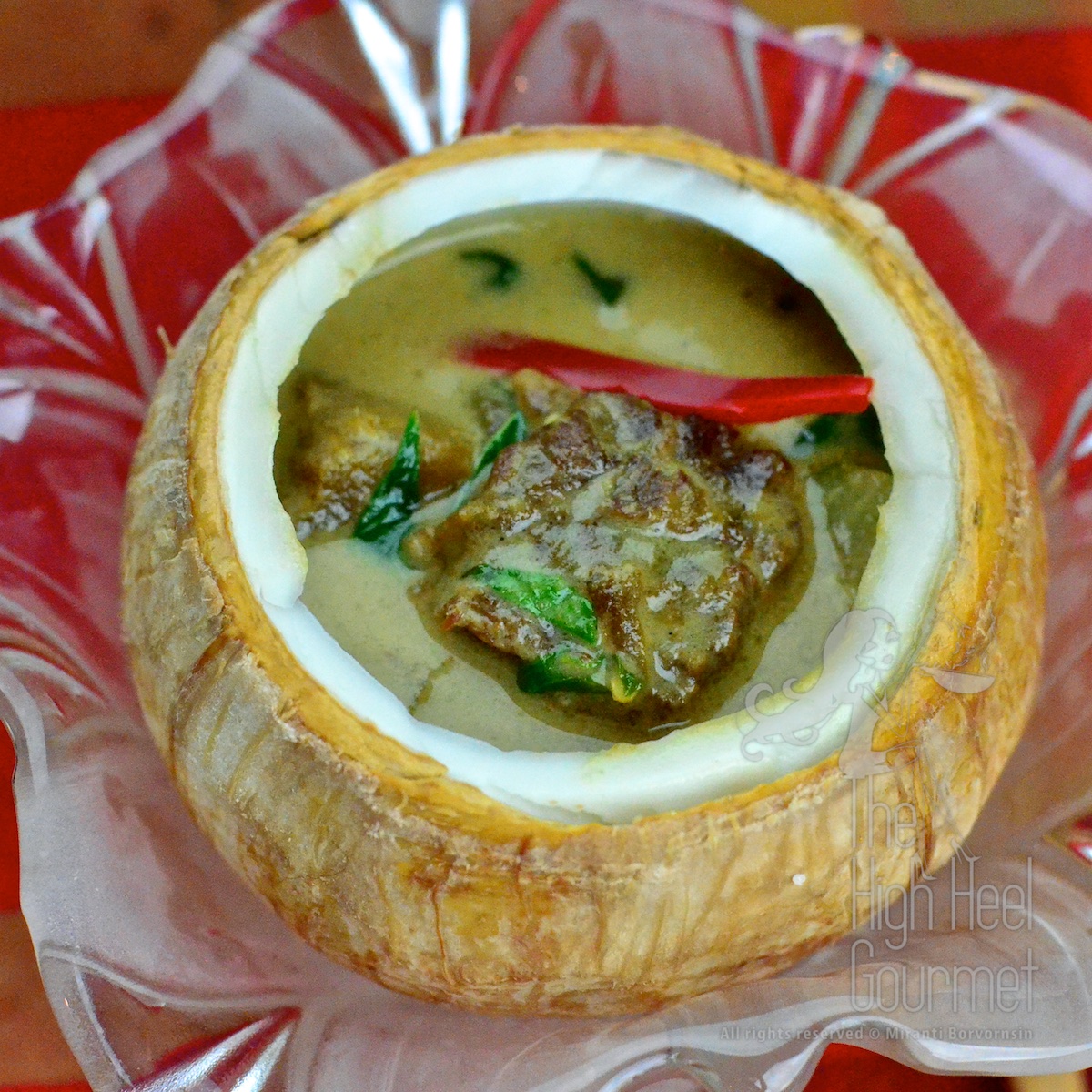
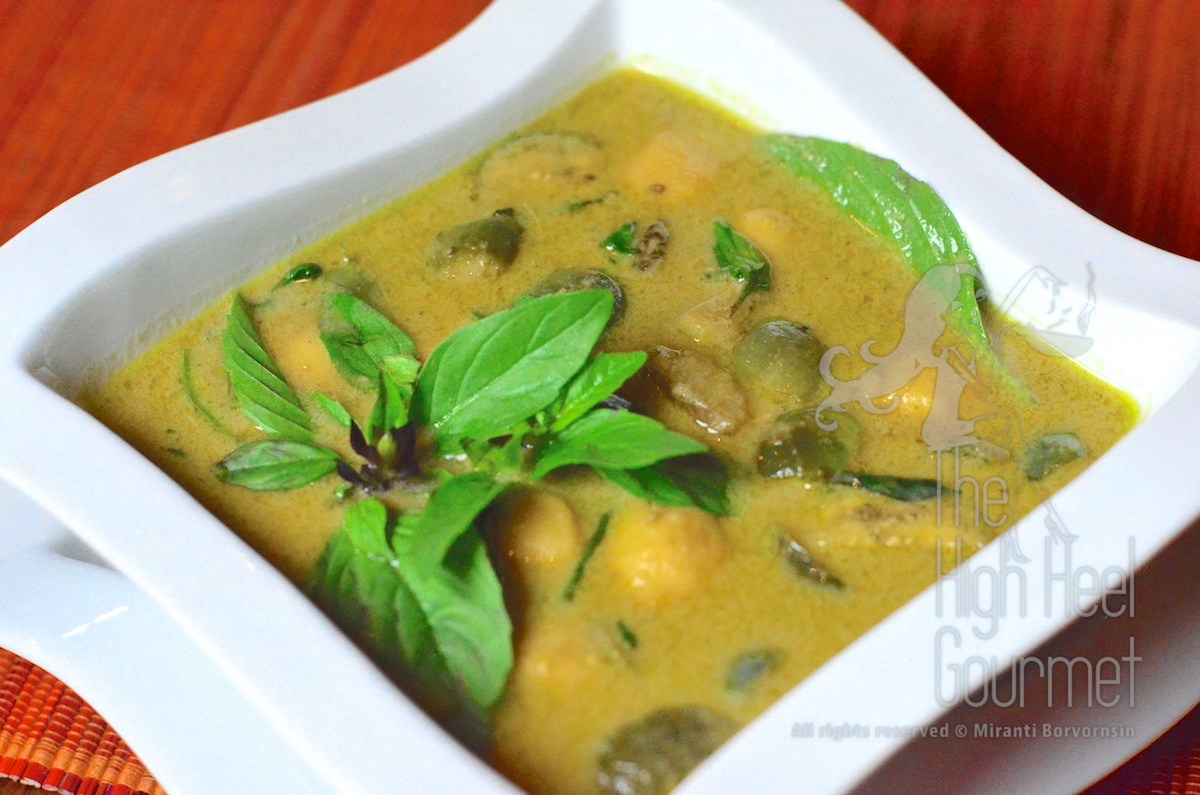
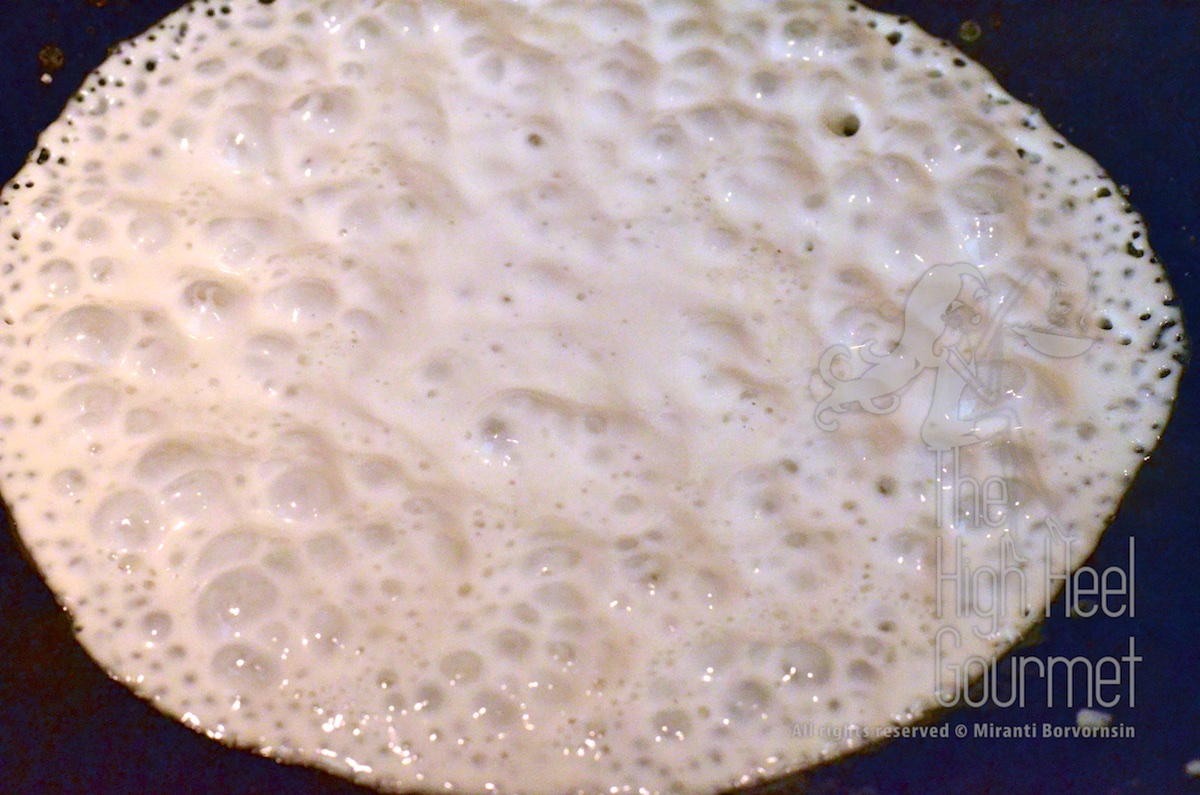
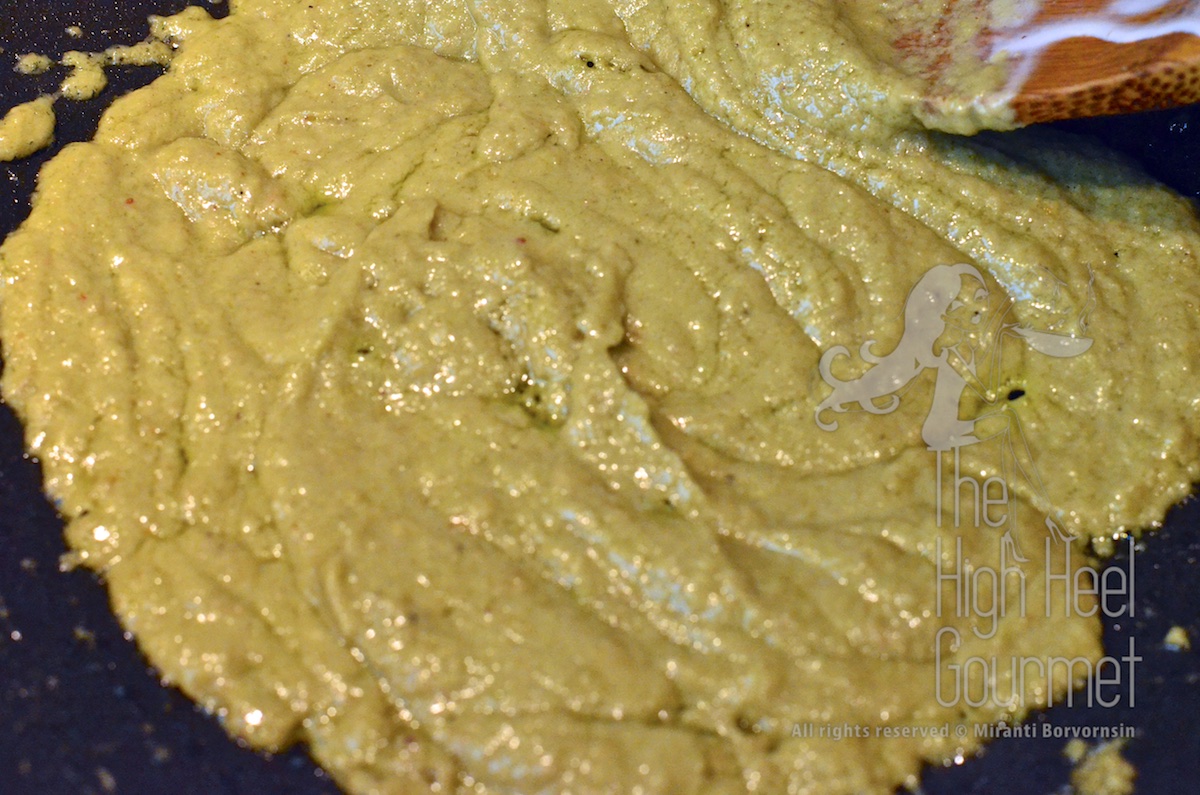
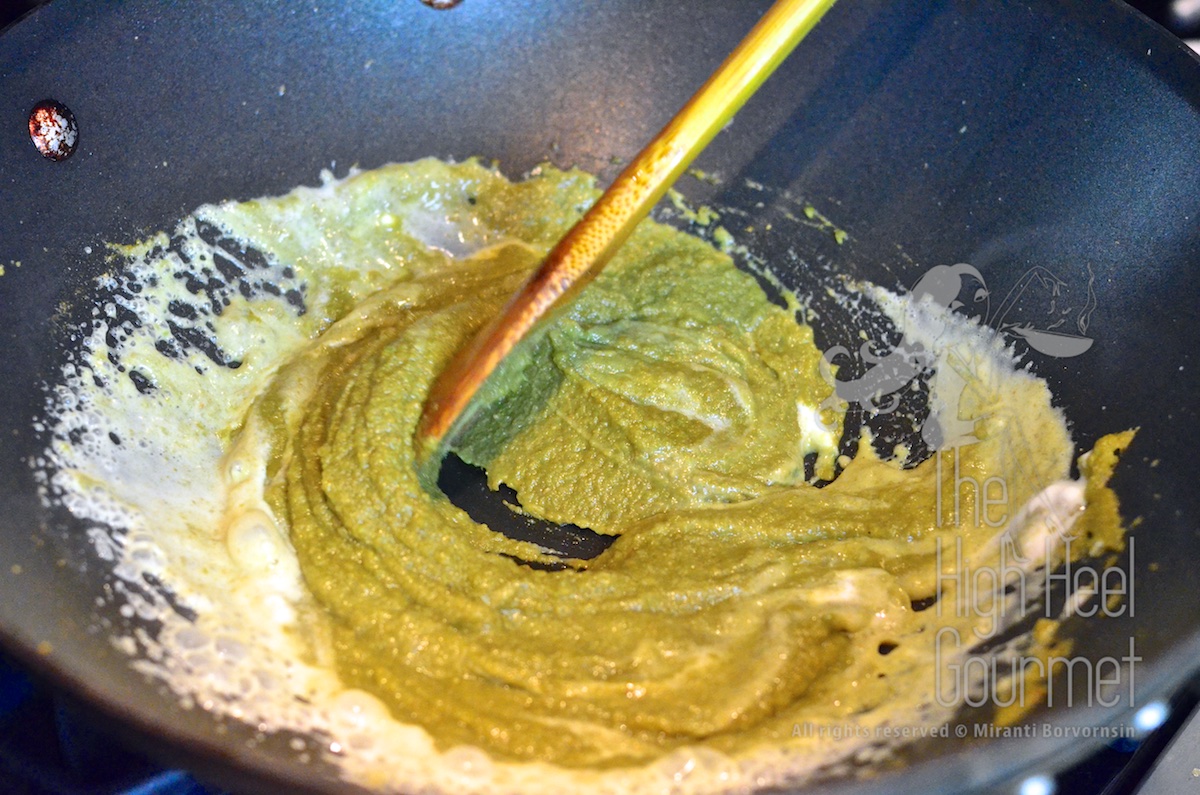
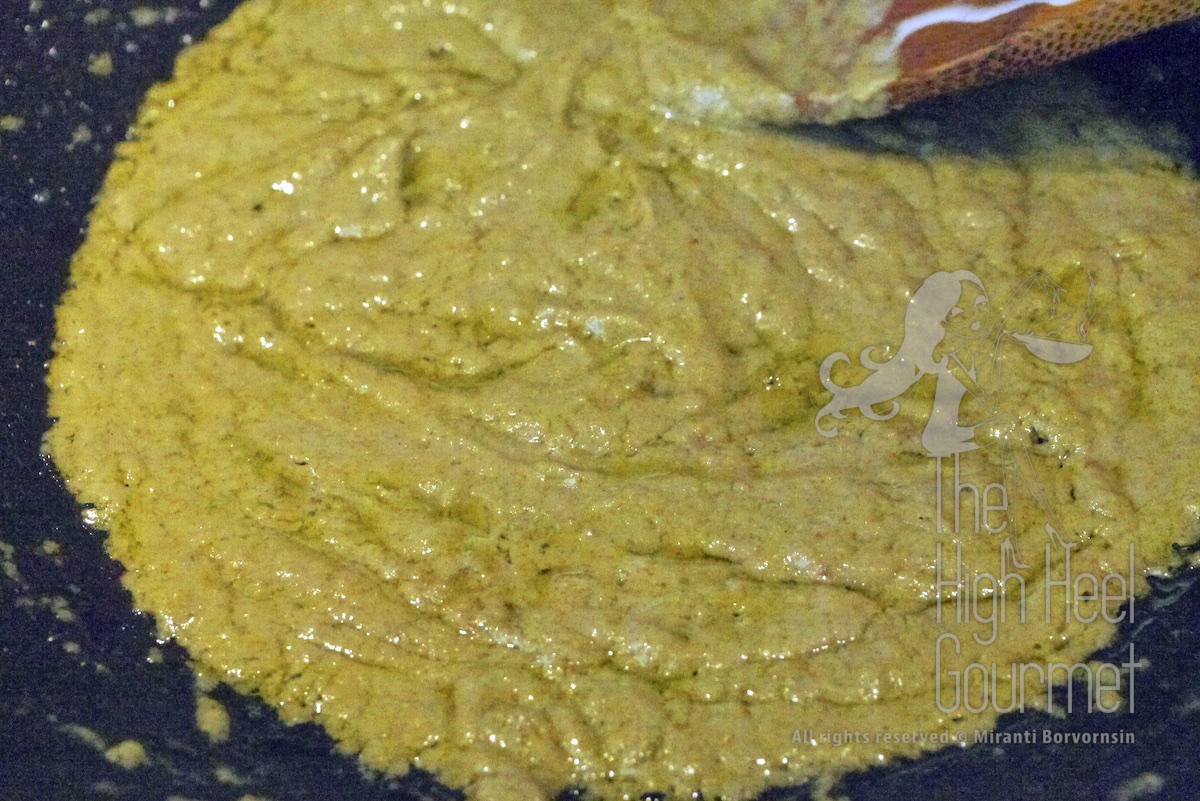
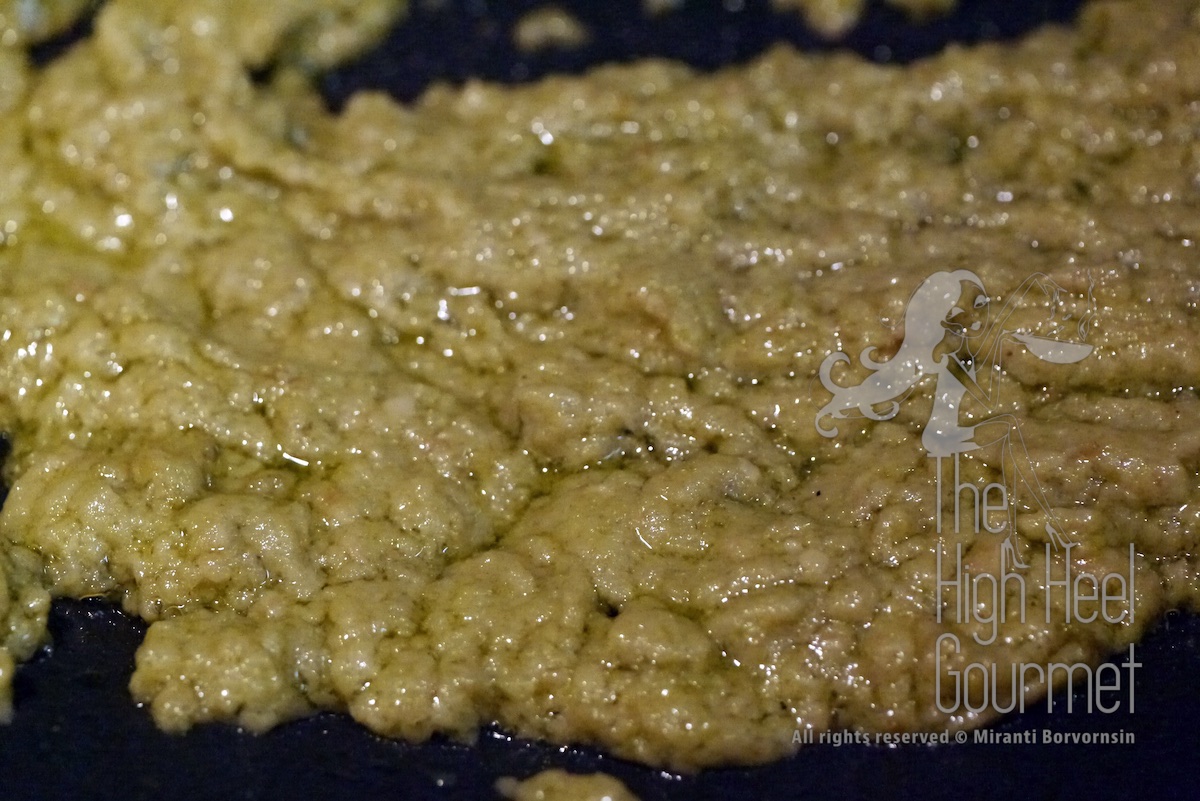
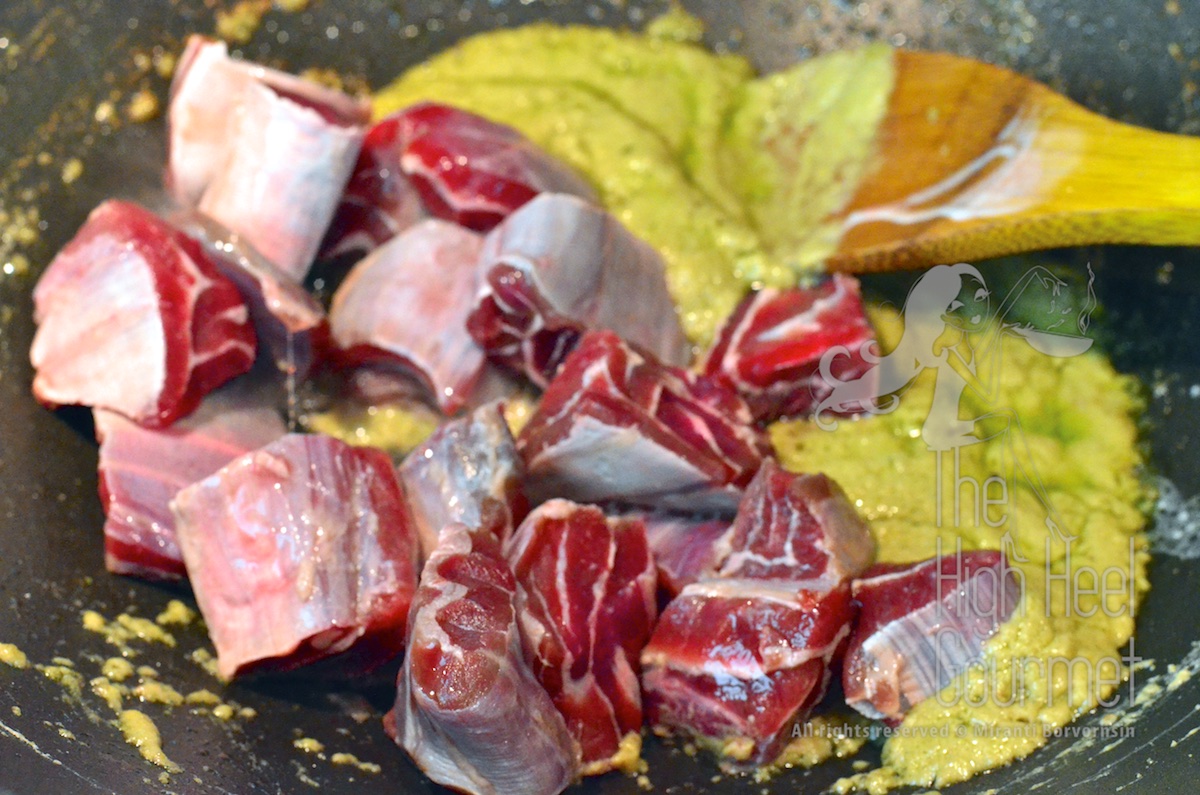
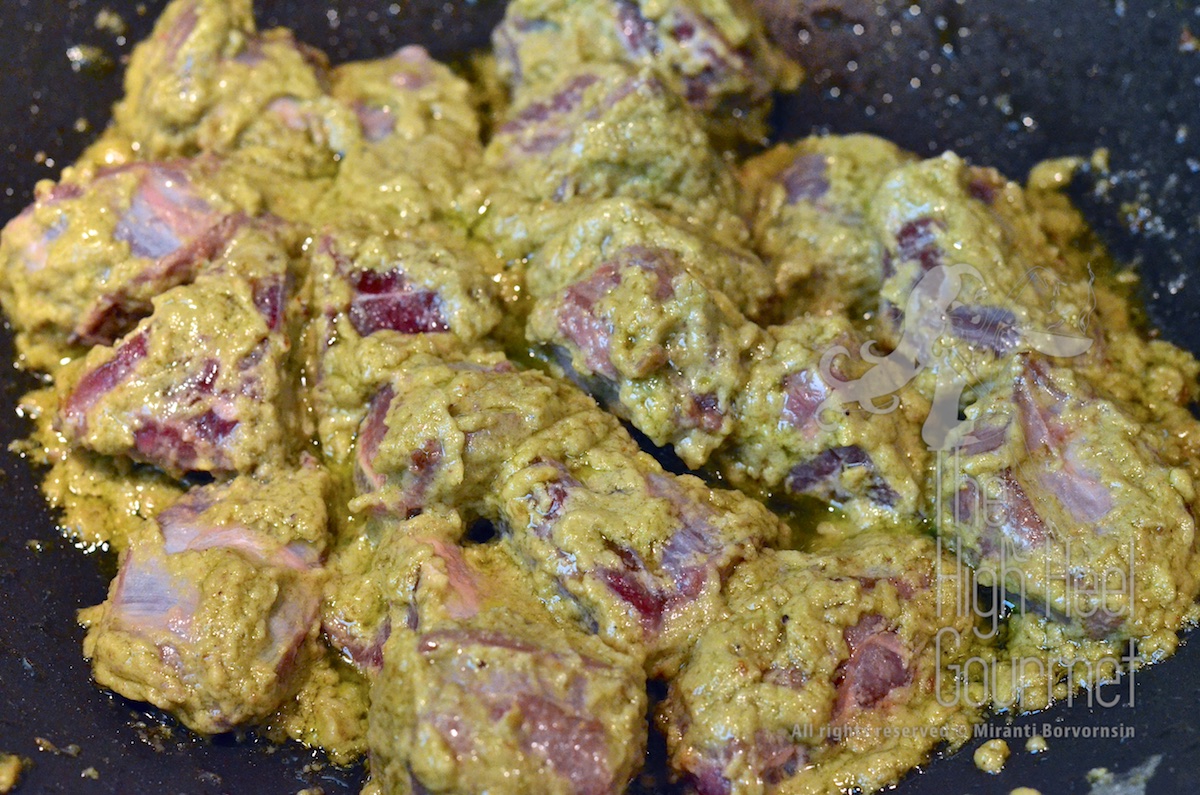
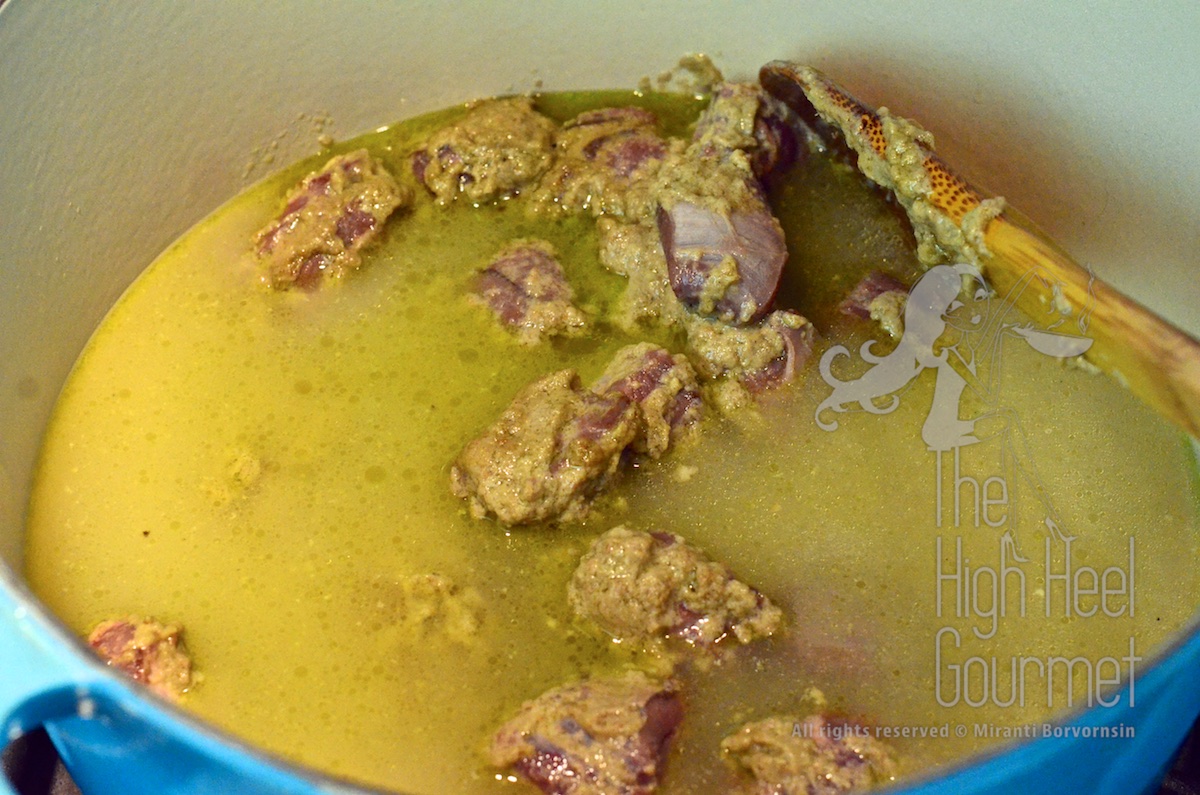
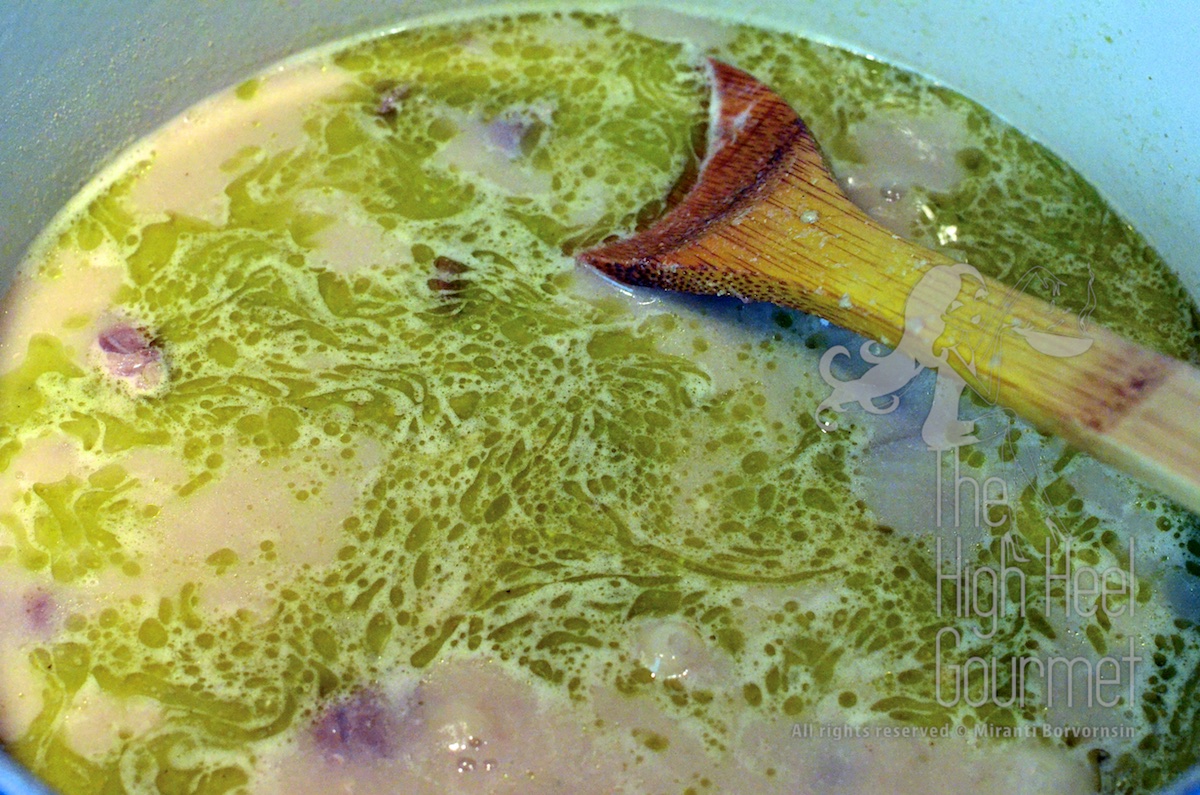
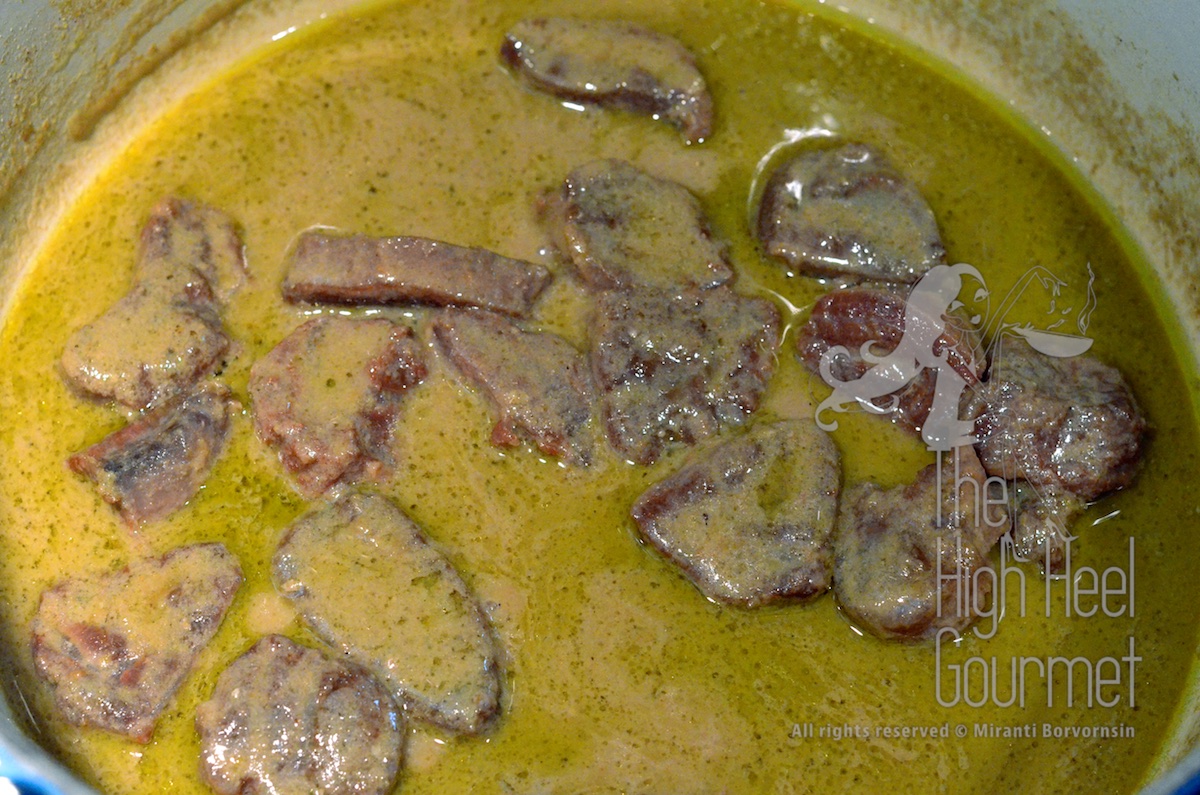
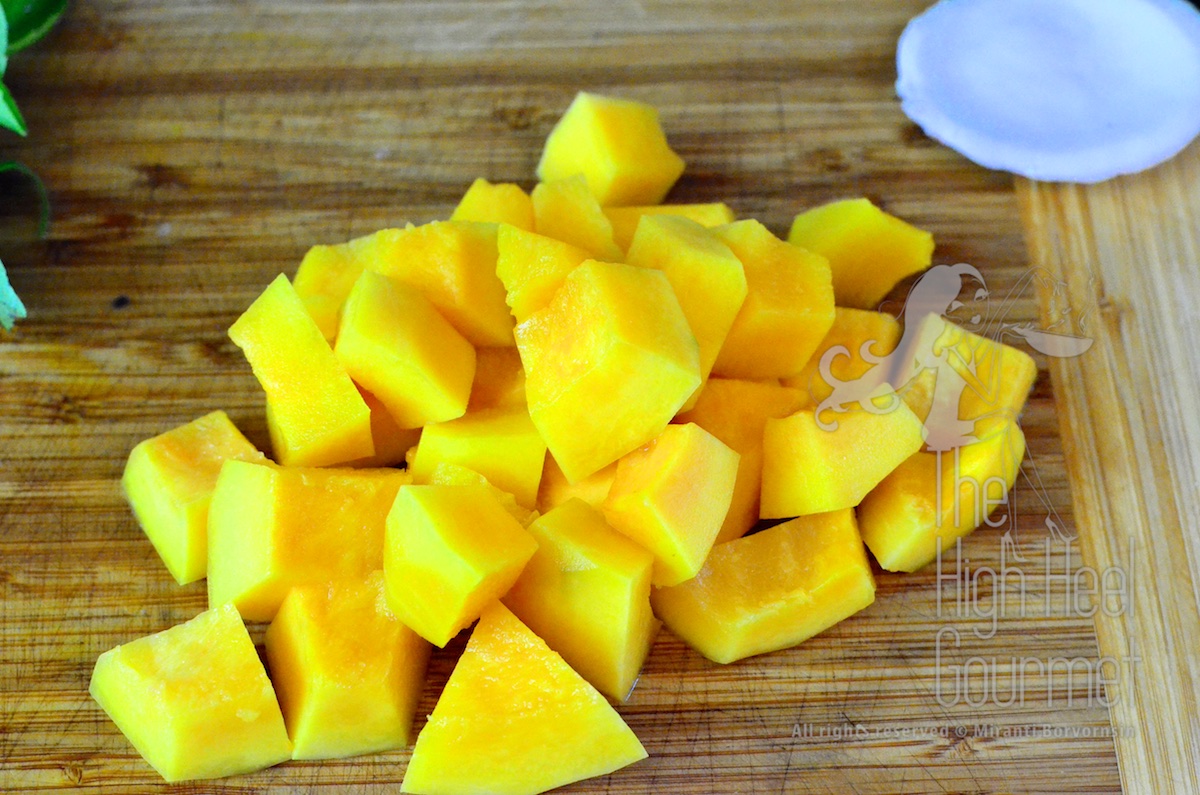
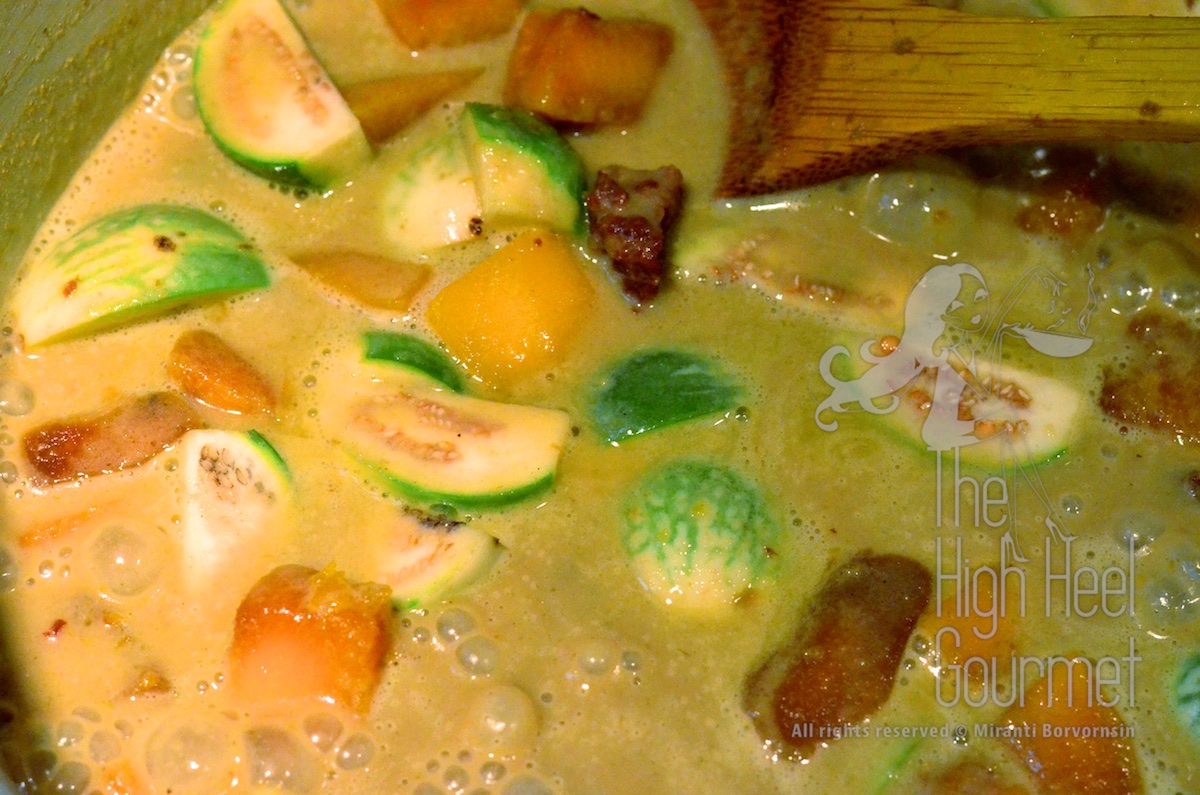
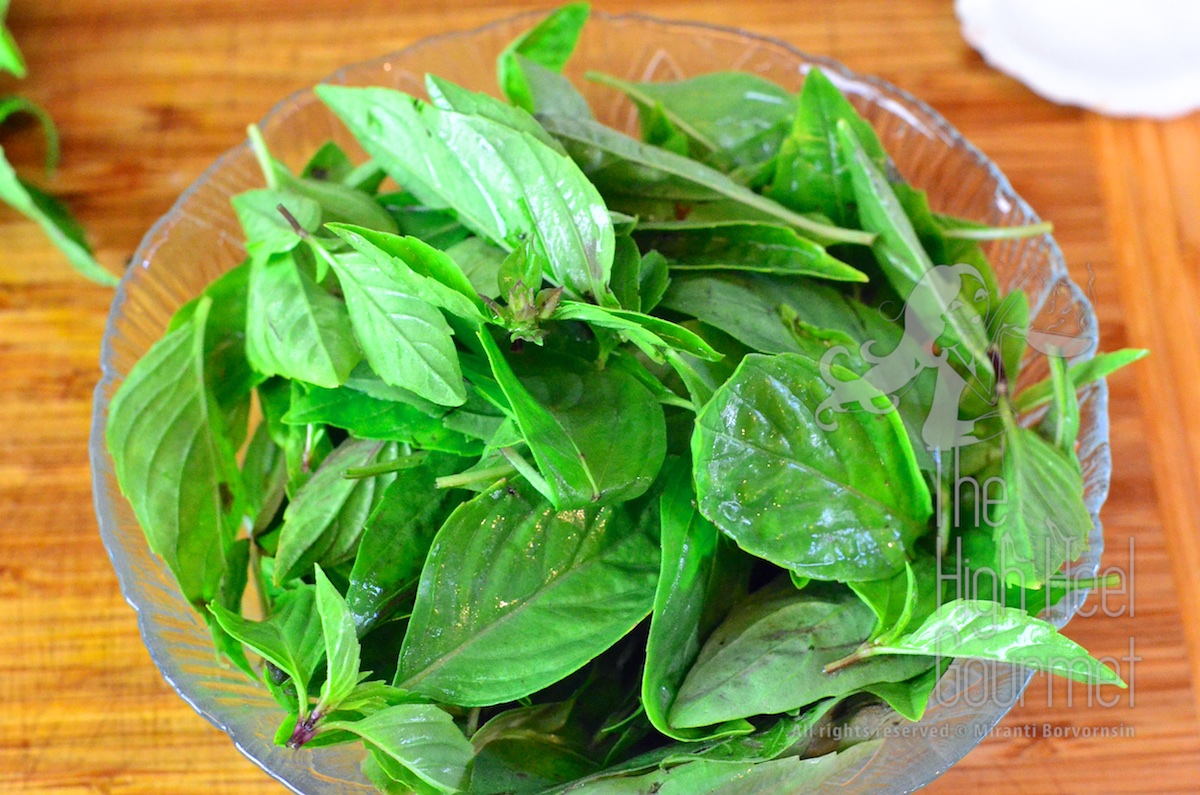
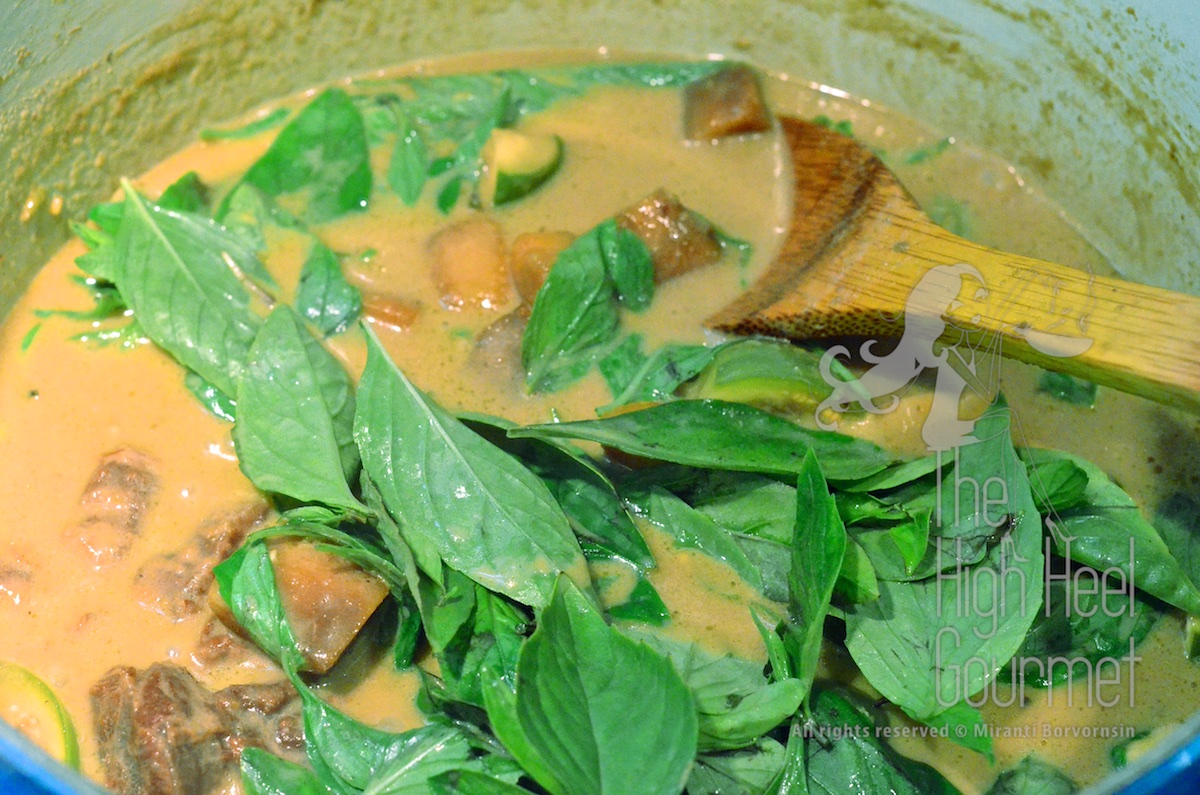
As always simply superb instructions and stunning photos. Truly brilliant.
Thanks 🙂
Thanks so much for your excellent instructions and explanations. They have made this recipe seem doable.
It is doable…The great part is either do it right or not, at the end you get a pot of yummy curry!
One of my most favorite dishes. Maybe I’ll even try this at home! Thank you.
lol…you are equipped now!…try it.
This post is marvelous. I found your descriptive instructions inspirational and can taste the ingredients as I read through the post. Keep them coming.
Thanks 🙂
Amazing, love your presentation.
Thanks
How many times can I say how much I love your posts – my favourite food – your instructions/descriptions/knowledge/pictures are outstanding – this looks truly wonderful! 🙂
Are you Thai?I would like to know how to cook Tom Yam as Thai are well known for their Tom Yam.
Yes, I am Thai. Follow my blog, I can put Tom Yum recipe on after these two requests, Pad See Ew, Mango and sticky rice, then the next one can be Tom Yum in about 3 weeks.
Thank you very much.
So much detail here! Thanks for sharing!
O gosh, that looks lovely! You know I love Thai food especially here in Holland, the weather is just… well; autumn all year. Grey, rainy, cold and windy. A Thai curry with coconutmilk and all spices is comfort food. Warm, creamy and a lot of zing!
Sounded like Manhattan Beach, CA…lol…well I’m stretching it but Manhattan Beach is getting a lot of fog especially in June. I do like warm spicy soup too but I eat it with fluffy rice (white of course).
BTW: you create great colorful arts.
Beautifully instructive post, can’t wait to give this a try. I think I am guilty of making ‘thai style’ dishes. Never again. Thanks for dropping by The Food Plot!
It’s ok…If you want to make your “Thai style or Thai inspired” dish. I do that all the times with other cuisine but I just don’t called it authentic. Food culture evolves, you know. I like your experiment with the celeriac. (That’s how I found your blog.)…If you want to make it vegetarian you can substitute the meat with Tofu or just put only vegetable….Thanks for visiting.
Fantastic post! Great instructions to follow. I love curry. Now I just need to be brave enough to give this a try!
Go for it!…You can do this. I just make simple matters complicate…hahaha…my specialty, you know. It’s easy and the plus is, even though you don’t make them the right way, it’s still come out delicious!
Thai food, high heels and great cooking?–kind of kinky!
Kinda all necessity, you know, Thai food, high heels and great cooking…may be kinky is necessity too…lol…
I love Thai Foods ~
I’m glad. Me too 🙂
Thanks for visiting my blog and it led me to a whole new world of curry and spices. I will definitely be coming back although l don’t think l can pull off your recipes just yet.
Next week will be a simple recipe but I’m not sure if you know the dish. It’s called Pad See Ew.
Looks yummy! Love green curry. Thanks for sharing!
🙂
I like Thai food and have been to Thailand. Unfortunately, there’s few Thai restaurants where I live (Tallahassee, Florida) because it is Deep South, where there are three major types of cooking: fried; deep fried; and very deep fried.
Assuming I can find the ingredients in our only Asian market, I may try some of your recipes.
If you can’t find them, you can either ordered them from online places I gave links or substitute it with anything else you can find. I even used the Italian sweet basil in place of Thai basil if I can’t find them. The online store have most of the ingredients for the curry paste. If you can’t find cilantro root or kaffir lime, just omit them or order the green curry paste and use that instead.
BTW: I LOVE the southern foods…they just know how to make food tastes good haha. Can you tell that I love fried foods? The Peruvian got me to eat there cute guinea pig by deep fried it! I didn’t know which level. It’s between deep fried and very deep fried for sure 🙂 and no underwear line present…muahhahaha
This looks delicious! Thanks for sharing 🙂
🙂
They are great and elaborate trilogy posts of Thai curry paste. I have to read the posts all over again and really digest them. Thank you for the lessons. 😀 Fae.
You are very welcome. The post in the long run would save a lot of my time that I have to “talk” or “teach” my friends how to do it right. So I think it worth the time. :)…Glad that you found it helpful.
This looks really great! Did you enjoy eating it yourself?
Yes, I love the green curry!
Wow, this is magnificent!!
Thanks
Amazing!!!! A ton of work to write this post too!
Still not enough for a complex matters such as Thai curries! Thanks for visiting.
This is wonderful and fabuloso!! Bravo on this one. How interesting the image with using the coconut as a soup bowl. I just happen to have coconut water with my meal tonight (Thailand coconuts). I will be pinning this to my Pinterest page.
Great food creation!! 🙂
Hope to see you over at Fun with food ().
Randall
I’m using the coconut shell as a food container in Tom Yum Goong too 🙂
A real ingenues idea. I like it!! I had more coconut water today!! Coconut is great.
Thanks for your recent visit as well. Hope you can follow my blog as you do my Face Book. 🙂 I always appreciate your comments as well.
Regards,
Randall
Yes, I do following your new blog 🙂
Thank you!! 🙂 I always appreciate your visits and comments.
Regards,
Randall
The Thai basil added at the end, do you eat it with the curry? Or is it just to add some flavor and you discard it when you eat the curry?
Also, is it OK to add coriander leaves at the end? Or that is more appropriate for soups?
thanks again for the best article I have ever found in the net about curry making!!!
You eat the basil with the curry. They are thinner than Italian or regular basil.
There is absolutely NOT OK for cilantro leave in the curry. If you go to any Thai restaurant and see cilantro in the curry, they are not authentic.
You are correct about cilantro in the soup, mostly clear broth soup.
My tastebuds cannot thank you enough for this!
Much love & thanks to you <3
I’m glad 🙂
I might be doing something wrong, but after many attempts I have not managed to brake the oil from the cream
I have been using aroy-d brand which , as you said, does not have emulsifiers gear gum…
But there are many formats of aroy-d : there is tinned 60% milk – 40% water, 100% milk in tetra
So, I’m a but confused…
Which one are you using: 60 or 100% milk, tetra or tinned?
Does it matter?
Cheers
Can you tell me a bit about the heat?
I normally use the coconut cream 100% one. If I only have the coconut milk I scoop only the cream part and save the water part for later.
If you are using too high heat, it will burn before breaking. I put the coconut cream over the medium-high heat wait until it bubble and watch the edge. If it gets dry, I drizzle the edge with more coconut cream or coconut milk or water (water will evaporate anyway) and cook it a little more also keep drizzle more cream.
Did the aroy-D come in the can or the box? (I’ve heard the complain about this brand in the can don’t break from my Thai friend in Europe but I can get it to break with the product they ship here).
How long you cook it? 5 minutes? 3 minutes?
Thanks for your suggestions!
– I use medium to high heat, but it still might be to high
– I dont remember the cooking times, but i would say it is around 2m the coconut cream + 2m with the cream with the paste together =4m in total aprox
– I buy the canned one, and I scoop the cream from the top
I am gonna try to reduce the heat a bit to allow cooking for longer and also drizzling the edges of the wok when it gets dry
Thanks a lot for your help. You are such an inspiration!
Mik
I have just found in the internet that Aroy-D in tetra is UHT (ultra high-temperature)
UHT is a process to preserve highly perishable milk by heating at very high temperatures to kill bacteria for a very short period of time
This type of high heat treated process makes the milk very homogenous, and does not separate as a result of that…
so skip this one to make curries
Just thought that something else might find this info useful 🙂
You nailed it Mixy!
Wish I had found this a few hours ago..
I just made green curry paste while breaking some of the core rules (cilantro, thai basil, green onions, normal lime), was still tasting amazing but will try the real thing next time. 🙂
Thanks for this…
You might already use to your own creation by now 😉 Nothing wrong if you like it that way just don’t call it Thai so, Thai people don’t have the wrong expectation but try the authentic one just to know what it’s all about.
I noticed that your instructions don’t include the addition of whole kaffir lime leaves while cooking the final dish. I often find whole kaffir lime leaves in the green curry that I eat at restaurants and was wondering if this is something they do in Thailand as well or just an American adaptation? Thanks for the recipe.
Nelson
That can be done too. It’s not an American adaption. My family don’t normally put the whole kaffir lime leave in the pot of green curry unless it is for fish curry or fish balls curry. This is merely preference.
The chef at the restaurant that you went to probably like the stronger kaffir lime flavor. I don’t put it it because my curry paste already contain kaffir lime peel and I don’t like to over power my curry with more kaffir lime.
They also do that in Thailand as well. Kaffir lime is used to cover up the fishy smell of the fish and seafood mostly but some people like it in chicken or beef curry as well.
Sometimes when I fry the curry paste in coconut cream and I get the oil to separate, when I add the rest of the can of coconut milk, the oil is absorbed back into the rest of the milk? Am I adding the coconut milk too soon?
Which brand of coconut milk were you using? Is sounded like you were doing all the right thing but whatever the binding agent used in the coconut milk had reversed the effect. It happeded to me before too but not with the pure coconut milk that I squeeze by myself.
I used Arroy-D this time, but usually I use Chaokoh. I just read your caption in the last photo of your post and you wrote that sometimes a high starch vegetable will result in emulsification of the oil. I added a lot of eggplant (used regular eggplant instead of hard-to-find Thai this time) so maybe that was why?
Ahhh…this time is not high starch but the eggplants had absorbed the oil…bingo! I bet the eggplants are nice and soft though.
I think I solved my problem! I made a pot of massaman and tried doing it 2 different ways – 1 in a larger bottomed pot and 1 in a medium sauce pan. The curry in the larger bottomed pot came out with a beautiful layer of oil whereas the curry in the smaller pan had few tiny puddles here and there.
Now another question – what does curdled coconut milk in a curry look like? I’ve read recipes that have cautioned against boiling too vigorously otherwise the coconut milk will curdle. I wish I had paid better attention to my dad’s cooking. *sigh* I recall him boiling curries at times. My curry doesn’t look curdled, at least not really, but I feel it is rather thick and creamy (with the layer of oil). I accidentally boiled the curry with the coconut milk in it so one curry is slightly more liquidy than the other, but looking at the liquid itself, I don’t see any visual evidence of curdling, or at least not what I would consider curdling.
Curdle coconut milk!?!? Just from the way they said about boiling it too long, I would assume that it’s not “curdle” they’re talking about. It’s just the cream and oil had separated, or “breaking” not curdle.
I’ve seen people making coconut oil (obviously not cold press to get virgin oil that’s selling all over the Internet right now). They boil the coconut milk for hours. The longer they boil, the more oil would separate and float up top. The cream or milk part would diminish and set at the bottom, look like some kind of sediment. It kinda look like milk curdling a little bit.
I’m so excited to try this recipe for a dinner party this weekend as well as your pad kee mao recipe. I need to make enough green curry for 8 people. Should I double the ingredients in this recipe or will it make a pot big enough to feed 8? Thank you so much for all of your amazing and authentic recipes!
You can double the recipe but traditional Thai style the curry will be served with other dishes. You can try with this Thai omelette http://www.highheelgourmet.com/2012/11/14/thai-crispy-omelette/ or pork/chicken (the other kind of meat different than the one you used in curry) fried with garlic and pepper http://www.highheelgourmet.com/2014/10/18/todd-kratiem-phrik-thai-fried-meat-with-garlic-pepper-thai-style/ or fish with lime and garlic http://www.highheelgourmet.com/2014/03/09/salmon-garlic-lime-sauce/.
Hi
I’m a British South Asian.
I’m so SOOOO excited to find Your blog
❤️💜❤️💜❤️💜
My 18 year old daughter and I absolutely love thai food and I’ve researched and practised various dishes over the last few years though I’ve been making Chinese some food for over 20 years now. She really loves pad thai, the tom yum/tom kha soups, green curry, mossamam and red curries. The fish cakes, chicken satay, peanut sauce and all the dips etc
I wish I could afford beef, lobster and crabs to try out.
But we gain loads pleasure from what we can make.
I’m really enjoying reading your detailed posts which include loads of great informative history.
Your pad thai post made me feel your emotions as I share your strong feelings love pride and passion about the authenticity of the dishes that are an integral part of us and our culture and heritage.
It’s always so upsetting to see Impostors posing as authentic. I really understand why you were so upset about that cook.
I agree totally with you that call a dish “your own version “of whatever but not it’s authentic title if it’s NOT actually that.
I get so annoyed when I see brief idiotic “easy” recipes for Biryanis using non basmati rice etc
And so called curries.
Thank you so much,
Your the only blog I’ve ever subscribed to and I’m sure I’m going to learn so much from you in my ongoing quest to learn and create authentic as possible thai dishes.
Regards
Samina
Thank you so much, Samina! You are exactly who I am writing my blog for. I’m so glad you are trying so many of the recipes and enjoying them. If you ever have any requests for dishes please tell me. And maybe someday you can teach me authentic Biryani!
Hi Miranti
You mention Coconut palm sugar in the list of ingredients but I don’t see in the instructions the moment in which you add it to the food.
Is it when you add the salty bit (the fish sauce)?
Does it matter if you use normal or brown sugar instead?
Thanks
Yes, I wasn’t that clear in the instruction. It’s in the step 4, when you season the curry.
And yes, you can substitute the plan sugar with any sugar.
Thank you!
Thanks to your great instructions my curries are getting better all the time!
Hi again 🙂
I have a question about coconut cream.. .last weekend i was in an indian market and i bought a brick of “creamed coconut” that a recipe i wanted to cook called for.
In contrast to coconut cream, which is a dense liquid, this looks like a hard block that you have to mix with water. Is this common in thai food?
Just in case you know, what is the difference between coconut cream and creamed coconut?
Thanks
It’s the same thing. The Indian block of “creamed coconut”, was it cold?
To make coconut cream, all you have to do is either warm up the coconut milk but don’t boil and wait until the cream float up to the top and scoop it up or put the coconut milk in the fridge and scoop up the top creamy part. You usually need to diluted the cream with water.
Yes, that is it. It is a cold white block
In the indian Chicken curry i cooked, I threw it straight to the pan, which already had water on it. So, it diluted…
I was wondering whether there would be any differences in taste with the standard coconut cream
Thanks again!
If they don’t add anything to it such as salt (also act as preservative), sugar, they should taste the same, creamy and slightly sweet naturally.
The Indian creamed coconut should thaw and get coconut cream as a result. I assumed that the creamed coconut would not contain the binding agent and can easily “break”.
Hi!
Your blog is truly Godsent! Thank you for such detailed and authentic recipes. I love Thai food and can’t wait to try making these pastes at home. I do have a quick question though. I am a vegetarian and would love to try making this curry with veggies only. Can I use some other veggie combinations apart from eggplants and squash? Would mushrooms/babycorn/bell peppers/carrots taste ok? Also would I need to stir fry them separately and then add to the curry pot?
Thank you very much! 🙂
You can use your own imagination and nothing at all wrong with the veggies. Authentic Thai will not use more than two types of veggies in the same pot but you do not need to stick to that.
Have you ever try winter squash or winter melon? It’s wonderful in curry. Watermelon rind, kale, sage (will add sourness to the curry), Swiss chard, Brussels sprout, jicama. They’re all good. And don’t miss out on the fruits, pineapple, apple peaches, grapes, nectarines are wonderful in the curry too, just don’t cook them too long.
Hi, Thanks so much for your wonderful recipes. I have a quick question what can I replace coconut cream and coconut palm sugar with? Can I use milk in replace of coconut cream ? and sugar instead of coconut palm sugar?
You can use half milk and half cream but you cook it differently.
Stir fry the curry paste with the cream at medium heat for at least three minutes until the paste cooked and the cream break into oil a little bit then you lower the heat to medium low and add milk. Do not let it boiling over. It might curdle. Sugar just use granulate sugar but cut down the amount to about half-3/4.
A great recipe, very authentic.
Quick question….how many people does this recipe serve?
Also, with authentic green curry that you buy in Thailand, is the curry thick or thin?
Thanks,
P.
This is for 2 if you only serve one dish. If you serve multiple dishes this can be a part of dinner set and can be good for 4.
They serve thinner curry in Thailand. Thick creamy curry are served mainly outside Thailand. It’s too thick and too greasy for hot climate.
Have you ever tried this with mango?
Mango and tofu are also great in this too but put the mango last and don’t cook them for too long.
I fell absolutely in love with green curry years ago and have failed miserably trying to replicate it with countless recipes! I just made this tonight following all of your detailed instructions on separating the coconut milk and really cooking the curry, and oh my goodness I will be making this all the time now! My only complaint was my curry was wayyyy too thin. The flavour was certainly there but the consistency was off, more like oil water. To thicken it up a bit (not really thick though I don’t like it when it’s served like Greek yogurt I want it a bit thinner than cream) do I add more coconut milk at the end of cooking? Also instead of water have you ever used chicken stock?
You add more coconut cream toward the end before you turn off the heat (to prevent it from breaking). To get the coconut cream, chill the whole can in the fridge and skim only the white top part.
I don’t use soup stock but you can. In our cuisine, we don’t normally use soup stock, we can’t keep it from spoiling due to the climate. I also don’t use any canned food unless, I canned them myself.
Hi,can i omit the thai basil?will if affect the taste of the curry?mi cannot seem to find it. Thanks
Sure you can. If you can’t find it, you can use Italian basil too.
HI, I did as the instructions say, but it was pretty thick, do I just add water to make it thinner?
No, I wouldn’t add water. If you feel that it is too thick, I would add some wine or Champaign or juice. And remember to cook it less next time.
Thanks for the detailed instructions about how to fry the curry paste. It made all the difference for me. I started with a can of actual coconut cream (not the thicker part from a can of coconut milk) but I still couldn’t get it to break without adding coconut oil. Is starting with the cream okay?
Yes, start with the cream you can break it easier but it’s ok if you can’t get it to break. It usually takes 2-5 minutes of frying over medium heat, quite a while and sometime indefinitely, if you use the coconut milk that has so much additive added. If I use fresh squeeze coconut, the cream breaks in no time, like in a minute or two.
Hi!! Thank you for the detailed instructions!! I tried green curry in the US and totally LOVED it, but originally I am from Ukraine and it is impossible to find all the ingredients for the paste here. As a matter of fact, it was impossible to buy even the premade curry paste a couple of years ago. So now we have a chance to buy only the Lobo brand paste and it is quite hot)) How can I make it milder? Actually I already tried to make green curry with your instructions and it came out pretty good, but I figured out that I have to use only 1 tbs of curry paste so it can be eatable) maybe there are different ways to make it milder without loosing it’s flavor?
And one more question.. When I was stir frying the curry paste last time I used the coconut cream on the top of the coconut milk as you wrote. It was like 3 parts of cream and only 1 part of skimmed milk. I stir fried the paste with 2 parts of cream but when I understood that the dish will be too hot, I have set aside the half of the stir fried paste. Then I used the remaining 1 part of cream and skimmed coconut milk for the dish (it was only something like 100 g or less) and added some water. So now I have the half of the stir fried paste left but no more coconut milk and cream 🙁 it is still quite hard to find it here.. Can I just add more water while cooking the curry or maybe 22-30% diary cream will be not bad??
Thank you in advance)
Can you find a milder green pepper in Ukraine that is NOT the sweet bell pepper? If you can find it substitute the jalapeño and Serrano with those pepper but do not use the green bell pepper.
If you can’t, then your curry might not be so green. Or you can reduce the amount of pepper but keep the rest, garlic galangal, lemongrass, etc. the same amount. Also thus way your curry will not be so green either but you get the same flavor.
It’s ok to use some dairy cream with coconut milk. You are not going yo get the authentic flavor but you might like it more due to the familiarity.
If you already stir-fry the curry with the coconut cream, you can keep the other half and use it again in a few days but shouldn’t leave it longer than few days. It loose the flavor. My student claimed that she can use it up to a week just have to add more amount to get the same flavor. You can also try that.
Sorry for the late reply. I was in the middle of moving.
Hi Miranti,
I have read in other sources that coconut cream in a coconut milk tin separates better if you leave the tin undistorbed in the fridge overnight .
Is this really the case?
Thanks
Yes, you can definitely do that but that doesn’t ensure the ‘break’. That usually depends on the amount of binding agent in the canned coconut milk. If you want to know how does the cream break, try squeeze your own coconut milk and you will be surprised.
A Thai market opened nearby my house and so I was able to find some ingredients! It was very good… and a lot easier than I thought! Thank you for your recipe! Too bad all this coconut cream can’t be so healthy as to eat on a regular basis… 🙁
Good for you! I’m glad. And by the way look up the benefit of coconut oil on the internet. It’s much healthier than the dairy cream or butter but ofcours it’s not at a low calories point. (Isn’t what you referred to as being healthy?)
Hi Miranti,
Similar to several readers, I found your explanations and recipe to be very helpful after unsuccessfully trying other sites for the same. Your style is very witty. I made the curry twice from the same batch of paste and am noting my experience and asking some questions below.
I am South Asian and can relate to frying the paste in fat (in this case, coconut cream) till it releases drops of oil. The note about heat turning basil leaves brown makes sense. Before I found you recipe, I intentionally boiled thai basil leaves to death in a separate pan thinking that would release more flavor. I wondered why it still tasted flavorless, so I boiled them to their afterlife but they were dead!
Despite using your recipe for green curry paste and curry, my curry was unsatisfactory. I added all ingredients or substitutes suggested by you (Marmite, regular lime rind, frozen galangal, fresh lemongrass that was not too flavorful despite using the purple part). I hunted down marmite after visiting 7-8 stores in my town. The paste was a brownish-green and not very flavorful. Wouldn’t adding vegemite/marmite turn it brown? How is it expected to stay green? After I added the fish sauce to the curry, the taste changed for the worse. Next time, using leftover paste, I made the curry again and added lesser fish sauce but same issue. I actually took pictures of the paste and curry to show you, but see that there is no option on the comment form to add those.
So here are my questions:
Would not adding marmite/vegemite make this irrevocably brown?
Your curry looks a little brownish in the picture; is that usual for authentic thai green curry?
If using thai green chillies in place of serranos, how many should be added?
Does adding carrots, red bell pepper, canned bamboo shoots, tofu worsen the taste of the curry? This is what I used.
Thanks,
Nidhi
Are you vegetarian? I’m asking because you use fish sauce but use marmite for the paste. I would suggest using shrimp paste as the first choice but opt out for marmite of vegemite if you are vegetarian. The authentic flavor is the shrimp paste.
And yes, shrimp paste, marmite, vegemite will turn the paste slightly brown but I don’t use a lot of it. The function of these brown paste is to add the umami flavor to the curry. As I explain to someone earlier that due to the hot climate in Thailand we do not use soup stock so we add the umami flavor by using shrimp paste, dried shrimps, dried cuttle fish and fish sauce to flavor the soup. So, we don’t need a lot of them at all.
I never focus on making my curry ‘green’ because I can’t tolerate heat in chili so, I normally use much less chili than most people. My curry sometime came out so ‘white’ until I discover the jalapeno pepper and serrano chili, my curry start to look a bit greener. If you want your curry brighter green take some seeds and membrane out form the chili and add more green part. This is the most sure thing to get your curry green. You keep adding the chili until you can’t put up with the heat anymore then you starting to go to chili leave or basil leave for color.
If you want to send me pictures, go to my facebook page https://www.facebook.com/HighHeelGourmet/
When you send me the picture let me know what did you put inside there and how much too. So, I can guess better.
I wonder if you could use japanese miso paste as a substitute for marmite or shrimp paste
It didn’t work. The smell of soy fermented is different tone from shrimp paste. (I used the red darkest miso.)
Thank you sooo much for this great walk through of green curry paste and the curry itself. I have missed the flavour so much. I have actually resorted to growing all the ingredients myself under lights in a ‘grow tent’ or in the garden.
I just harvested my first kaffir lime and lemongrass, along with a big chunk of galangal rhizome and some corriander roots.
Just wow to the end result! It’s like I’m back in Thailand… I feel so happy and my mouth is the happiest it has been in years!
I went for a nice, thin, oily, hot curry and it is perfect. This recipe guide has been invaluable.
Thank you so much for doing such a good job. xx
Wow, you even grow your own galangal. I am impressed.
I’m glad you enjoy the curry 😊. I’m so happy when people appreciate the authentic Thai food and go through the trouble to make one just like the way we do in Thailand. Thanks so much.
Thank you sooo much for this great walk through of green curry paste and the curry itself. I have missed the flavour so much. I have actually resorted to growing all the ingredients myself under lights in a ‘grow tent’ or in the garden.
I just harvested my first kaffir lime and lemongrass, along with a big chunk of galangal rhizome and some corriander roots.
Just wow to the end result! It’s like I’m back in Thailand… I feel so happy and my mouth is the happiest it has been in years!
I went for a nice, thin, oily, hot curry and it is perfect. This recipe guide has been invaluable.
Thank you so much for doing such a good job. xx
Ahhh! I finally ‘get’ thai curry. Made this w/ shanks and little eggplants and it turned out perfect! Before I never really got the frying the curry part right. Other recipes are like just fry it for awhile and add some coconut milk. Once I saw your description and photos I realized it’s like making the masala for Indian food (which I learned from the Vij’s at Home cookbook) where you wait for the oil to shimmer on top. So excited I found your blog. Good luck on your new adventures!
Exactly just like that. The oil is the vehicle to transport all the spices flavors. (I used the same books to cook Indian foods)
Hi Miranti,
Hope all is going great with you and the HH gourmet in Switzerland!
Quick question: if using chicken thighs, any particular reason to go for bone-in or boneless?
thanks
It’s ok to go for boneless in Curry but traditionally they will chop up the thigh with the bone but then you have to spill it out.
I guess that mint cannot be used as a substitute of Thai basil? Mint grows very easy in my garden but basil does not… 🙂
Are fresh mint leaves used in Thai cuisine?
Cheers
Yes, we use them quite a lot in larb and the grilled beef salad.
Hi there,
Can’t wait to try this recipe out! As a vegetarian should I substitute the fish sauce with soya sauce, or is there a better alternative?
Thanks!
Mushroom soy sauce would have stronger flavors.
I would like to make southern chicken yellow curry. Would I still buy the Massaman curry or Kaeng Kua paste for yellow curry or is there a different one I would need?
This is southern curry paste http://www.highheelgourmet.com/2014/05/09/rice-noodles-salad-southern-curry-sauce-kanom-jeen-nam-ya-tai/
Yellow curry http://www.highheelgourmet.com/2014/03/15/thai-curry-paste-episode-xiv-the-yellow-curry-kaeng-garee/
Massaman curry paste isn’t the overall curry especially for Thai curry. It contains many more spices than most. Southern curry are so simple
This is the yellow curry http://www.highheelgourmet.com/2014/03/15/thai-curry-paste-episode-xiv-the-yellow-curry-kaeng-garee/
This is the southern curry http://www.highheelgourmet.com/2014/05/09/rice-noodles-salad-southern-curry-sauce-kanom-jeen-nam-ya-tai/
This is the simple southern curry http://www.highheelgourmet.com/2014/02/08/southern-chicken-curry-with-yellow-sticky-rice/. This is so simple they don’t make the curry paste.
You can’t use Massaman curry as an overall curry for Thai cuisines. That is the curry paste with the most spices. If you want to make you life easy by yawing pre-made paste, use the yellow southern curry (simple curry plus turmeric) and you can mix it with Kaeng Kua to loosen the sour taste of the paste. If you use the Mae Ploy brand, you probably don’t need to mix but Mae Sri in the small can, you do.
Thanks a lot for explaining the coconut cream/milk part. In most recipes I find online I see people seem to be afraid to break the cream, because it does not look nice or whatever. The way you prepare curries gives them a much more intense taste. Splendid!
Even cooking class in Thailand don’t normally teach this important part properly. They would say “cook the paste for two minutes” or “cook the paste until fragrant”…right…how can you tell the level of “fragrant” since the paste already smells through the plastic bag! Back in the day when coconut milk in the box or can contained too much bonding agent until it never break, I use to tell my friend to cook the paste right in oil at medium high heat for the intense flavor.